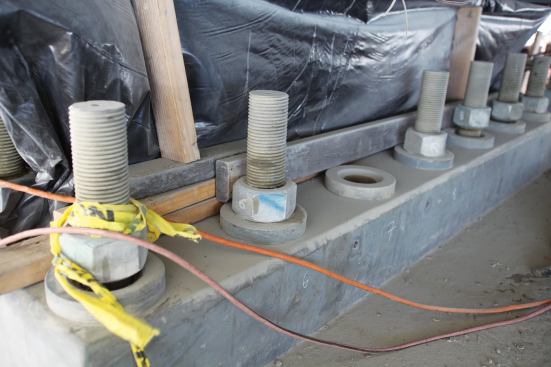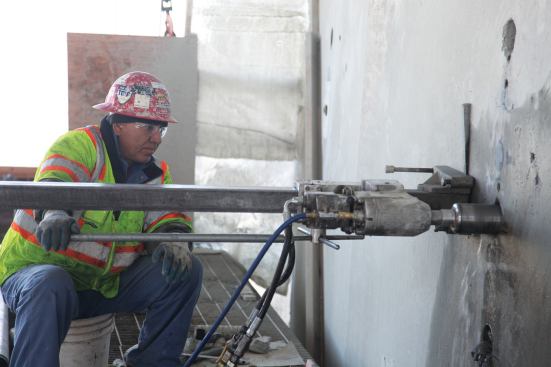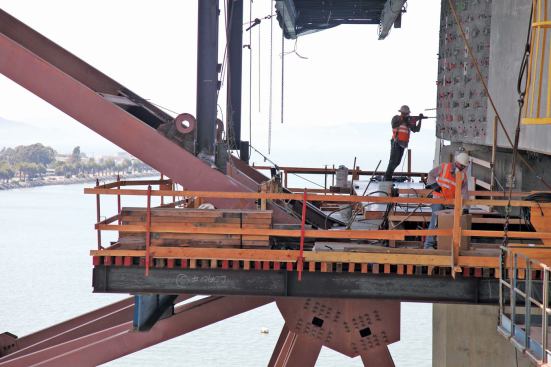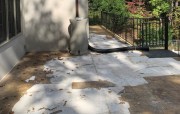



















Courtesy of CALTRANS
Approximate design of the steel saddle fix for broken bolts. Sad… Approximate design of the steel saddle fix for broken bolts. Saddles secure the shear key to the cap beam.
Courtesy of CALTRANS
Broken shear key bolts.
Courtesy of CALTRANS
Chiseled concrete awaiting steel saddle.
Courtesy of CALTRANS
Crews on the pier work platform drill holes for dowels to bond t… Crews on the pier work platform drill holes for dowels to bond the new concrete jacket to the cap beam.
Courtesy of CALTRANS
Drilling into the concrete cap beam to prepare for steel saddle … Drilling into the concrete cap beam to prepare for steel saddle installation.
Courtesy of CALTRANS
Drilling into the concrete cap beam to prepare for steel saddle … Drilling into the concrete cap beam to prepare for steel saddle installation.
Courtesy of CALTRANS
Dowels and formwork installation at the underside of Pier E2 cap… Dowels and formwork installation at the underside of Pier E2 cap beam. The 1-in.-diamater T-headed dowels were used to transfer saddle anchorage forces to the crossbeam.
Courtesy of CALTRANS
Epoxy and dowels installation.
Courtesy of CALTRANS
Crews on the pier work platform drill the concrete cap beam in p… Crews on the pier work platform drill the concrete cap beam in preparation for the bolt fix.
Courtesy of CALTRANS
Formwork installation at the bottom of the concrete cap beam.
Courtesy of CALTRANS
Shear key (middle) awaits broken bolt fix.
Courtesy of CALTRANS
Shear key with broken bolts sits between two bearings with good … Shear key with broken bolts sits between two bearings with good bolts.
Courtesy of CALTRANS
Applying liquid epoxy to seal the existing bolt locations at the… Applying liquid epoxy to seal the existing bolt locations at the shear key.
Courtesy of CALTRANS
Pre-stressing trumpets. Conco crews installed PT anchorages supp… Pre-stressing trumpets. Conco crews installed PT anchorages supplied by Schwager-Davis Inc., San Jose, Calif. They mounted 260 PT bearing plates and trumpets onto custom blockouts. Each of the anchorages accommodate an alignment specific to each tendon, per design specs. The blockouts had to be easily removed after concrete placement to allow timely installation of the PT strand.
Courtesy of CALTRANS
An upper saddle being delivered.
Courtesy of CALTRANS
Saddles replace the broken bolts and are attached to the beam wi… Saddles replace the broken bolts and are attached to the beam with PT cables.
Courtesy of CALTRANS
Two upper saddles and one lower saddle installed.
Courtesy of CALTRANS
Trucks on the road deck pump concrete to the bottom of the cap b… Trucks on the road deck pump concrete to the bottom of the cap beam. The injectable SCC concrete mix was designed to reach 55 MPa in approximately 10 days. The high strength was specified in the design, and the short duration was requested by the construction team to allow PT to take place asap.
Courtesy of CALTRANS
Pouring concrete base for the steel saddle retrofit. The geometr… Pouring concrete base for the steel saddle retrofit. The geometry of the soffit concrete qualified it as mass concrete, and thermal cracking was a concern given the heat of hydration with the concrete mix. Conco installed internal cooling pipes in the formwork and bay water was circulated through the pipe network during the placing and curing process. This eliminated any potential for internal/external thermal differentials that could cause cracking.
Courtesy of CALTRANS
Concrete in place at bottom of cap beam, encasing the web of PT … Concrete in place at bottom of cap beam, encasing the web of PT cable ducts and steel reinforcing. After all concrete was placed, approximately 2,500 0.6-in.-diameter strands were installed in the ducts and tensioned.


